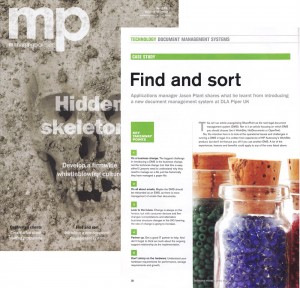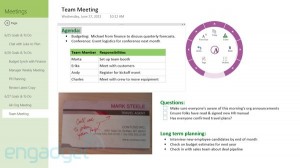Back in April I wrote an article for Managing Partner magazine. I was asked to hold back on publishing myself for a few months, but now you can read the post in full here.
This isn’t an article evangelising SharePoint as the next Legal Document Management System (DMS). Nor is it an article focussing on which DMS you should choose (be it HP Autonomy’s WorkSite, NetDocuments or OpenText)
No, the intention here is to look at the operational issues and challenges in running a DMS in Legal. It is written from experience of HP Autonomy’s WorkSite product, but don’t let that put you off if you use another DMS. A lot of the experiences, lessons and benefits could apply to any of the four listed above.
Key challenges to address in the DMS world
The challenges found when using a WorkSite DMS can be broadly placed into two categories. Those that are purely technical in nature and those that are related to end user usage.
The WorkSite application servers are the “hub” of the DMS and are fairly simple to maintain and monitor. From the technical view we have rarely experienced issues with these. We’ve switched from physical to virtual servers without difficulty and because more can be added as the business grows, they have proved fairly trouble free.
Sizing the other parts of the system for your firm is one of the biggest challenges. Examples of the issues we’ve encountered are problems because our database was not sufficiently powerful and in later years because our index servers were not sized correctly. The WorkSite application utilises SQL queries to work out and display your workspaces, folder structures and document content. This can be quite “chatty”, and ensuring your SQL Server can handle the transaction volumes for the size of firm and size of document database is key to a performant system. Processor power and RAM are the key variables here and if possible size the latter to be big enough to keep your databases in memory, this saves having to keep those database indexes constantly “tuned” to maintain a consistent performance. The indexer has become more an integral part of WorkSite with the IDOL engine from Autonomy integrated. As early adopters we found setting this environment up quite a challenge. Now Autonomy support provide recommendations based on specific details of your proposed platform and usage. However time taken with design of the IDOL environment will pay dividends over time.
Another challenge we have had as a firm is distance. One limitation of WorkSite is the distance of your end user to your WorkSite infrastructure, the further you (the end user) are from the servers the slower WorkSite will perform. Latency at work! (to be fair to HP Autonomy this is the case for most software!). There are a couple of technologies that can help here. Firstly HP Autonomy provide their own product to help in the “WorkSite cache server”: this is pretty much a WorkSite application server located nearer the end-user that caches documents locally; it takes away some of the “traffic” from the end-user PC to WorkSite servers, thus improving performance. The other option is to use network optimisers (or WAN accelerators). In our experience the later simplify your WorkSite environment and work very well, but this may not be the case in every environment.
Aside from the technical there are the challenges of the end user. Introducing a DMS is a big business change and this shouldn’t be underestimated. A DMS is a very structured way of filing electronic information and is never going to be as quick and easy as saving to the hard drive of a laptop. Managing this change is one of the key ingredients to success of the system.
Also once you introduce a DMS, from a lawyer’s point of view the whole of their Microsoft Office environment becomes the DMS. And from an IT point of view this can be problematic: there can be many pieces of software that all interact with Word and Outlook and getting them all to work correctly is one of the biggest challenges when upgrading.
Any tips for how to meet some of these challenges?
So what advice would I suggest to a firm embarking on introducing a DMS? And how can you address some of the challenges? I’ve broken this down into four sections:
1. Don’t skimp on the hardware!
This was alluded to when discussing the SQL Server and Index servers. Within WorkSite these are the key components to giving good performance, the rest you can scale out later e.g. by adding another application server. So take your time, work with an IT partner who can help with the sizing (or get access to Autonomy’s support site and take some time to read their guides on sizing).
Understand your likely growth, both in terms of year on year document growth and how you expect to grow as a firm. Project this information forward a number of years to get the storage size you will need, then add a bit! Also ensure you understand limitations in your hardware. You don’t want to fill that 1Tb disk only to find you can only increase the capacity by replacing hardware because the server you bought can’t handle larger drives.
What do you need in terms of resilience for the firm? Is redundancy in one environment acceptable? Do you want a hot standby disaster recovery site or do you want a full duplicate business continuity site? Each costs more than the previous, but build the best you can for what you need for your firm (talk to the lawyers to understand how the firm would cope without the DMS for periods of time).
2.Expect a trough of disillusionment after the business change

I find that Gartner’s hype cycle diagram is a great representation of the peaks and troughs of user experience when introducing a DMS. It helps to understand that you will hit a “trough of disillusionment” and prepares you to set off with the expectation that end users won’t understand or accept it immediately. This isn’t a smartphone app that is intuitive and can be picked up in no time without any training. Not only is there a big technical change, there is often a shift in how the business manages files, documents and emails. Plan for as much training is realistic; add earlier sessions a few weeks before with more of a presentation style in order to set the scene, and then do follow up training a few weeks after go-live. Effectively communicate and train the key objectives and the change as much as possible.
3. Understand your environment
Plan for the full lifecycle of your documents: understand how you’ll age your files, how you’ll retire them from your DMS to an archive, how you’ll delete files. This will usually be done in conjunction with infrastructure capacity management, but what we’re talking about here is the business view of archiving and storage not the technical. So think at what point a matter workspace will go from your live library to an archive; what will happen to it then etc?
Unicode: if you have overseas offices (particularly in places where the Latin character set isn’t the norm e.g. Russia, China) then you’ll want to watch for “Unicode”. It’s a bit complicated to go into the technical detail of ascii, Unicode, codepages etc here, but in terms of WorkSite just remember you WILL need to consider character sets if you plan to use version 8.x.
Business first: finally when planning your environment, firstly look at what you want from your business before considering the technical limitations. This will avoid setting up libraries for individual offices/countries because of latency issues when the business requirement is for the DMS to bring sharing of documents across all offices.
4. Get a partner
I’ve mentioned IT partners briefly already, but they are worth mentioning in their own right. It really is a benefit to work with a partner when implementing and running a DMS. Firms like Tikit and Phoenix will ensure you get what you need from the DMS. But as well as thinking about the implementation also think about the on-going support relationship; understand how knowledgeable their support team is as well as their pre-sales team and maybe even get them involved in the implementation project if possible.
What’s the impact and what ROI could you expect when using a DMS?
Our objectives in implementing WorkSite to replace an existing DMS were to gain:
– Full version control
– Email management/filing capabilities
– Storage of documents other than Word, Excel
– Integration with other legal applications (e.g. document comparison)
– Allow expansion (global)
It is easy to see that WorkSite (or any of the other DMS listed at the start of this article) fulfilled our objectives. However as the business changes so do the requirements and we’ve had a number of additional objectives to address based on the requirements of the business. The biggest has been dealing with the explosion of email. To illustrate this here are some rough stats on document numbers in just one of our libraries: in 2004 we had approximately two million documents with a negligible amount of email on the electronic matter files. We now have approximately twenty million “documents” in that library and over 80% of these are email.
The ability to serve a global firm is now taken for granted; the thought that 6 years ago lawyers in each office had great difficulty sharing a matter file with each other without having to email documents back and forth is a little hard to believe now.
These all are obvious benefits realised, however it is hard to measure a return on investment in terms of £’s. A lot of what a DMS brings is allowing end users to manage a good e-file. However if this is achieved, then cost savings can be made in the saving of paper and printing costs incurred in maintaining paper files (plus the subsequent storage of those files). Of course the truly paperless office is a bit of a myth, but a serious reduction can be achieved. And most people would be staggered by the costs incurred in this area alone in law firms!
Future challenges
So what are the key challenges for a mature DMS implementation? These will always change, but right now there are three looming large.
ILM (information life cycle management): how to control and manage the growing volume of documents/emails from creation to destruction. Planning this from day one would be a huge benefit (and a lesson learnt from hindsight!). Control can be achieved though, through use of tools like HP Autonomy’s workspace archive manager (WAM) which can move complete matter files from one library (database) to another (e.g. from a live library to an archive), maintaining meta data (like document number or document history). These archive libraries can then be moved to cheaper storage, separate archive DMS’s (which can have less resilience than the live environment where close to 100% up time is essential), backups and eventually retired completely if required.
Email: the growth is staggering and although the rate of this growth may be plateauing, even at the current rate it creates a very large volume of data to handle. Add to this the increasing number of devices emails can be created and consumed on and control can be a nightmare. I’ve seen lawyers with inboxes of 50,000 items: how on earth do you start to sort that into organised matter files? HP Autonomy have introduced the WorkSite Communications Server in recent releases that links the email and the DMS together at a server level. This allows a better experience to the user through functions like “filing folders” and “send & file”. But I can’t help think though that further work needs to be done by all DMS vendors in this area and leverage the storage that email systems are already using.
Consumerisation of IT: as the smartphone and tablet take off, then the demand for ease of use in the desktop increases, as does the demand for applications to use documents/emails from the DMS on the personal portable devices. HP Autonomy does provide an iPad application and I’ve seen impressive beta’s from companies like Prosperoware which take things one step further by adding your inbox so that you can manage all your emails on the move in one App whether in the DMS or not.
Summing up
The main piece of advice I would give if you’re starting on the journey is to both seek out an IT partner and also to speak to other firms and learn from their hindsight. These will really help with your planning. Also realise it’s a never ending journey!
A DMS is the bread and butter of a law firm. As such it is often taken for granted and seen as an “old technology”. But the demands of a law firm change over time as does the IT that is used to access the data. The challenge for the DMS is to keep up with these and ensure managing the electronic matter file is as simple, easy and efficient for the lawyer as possible.




